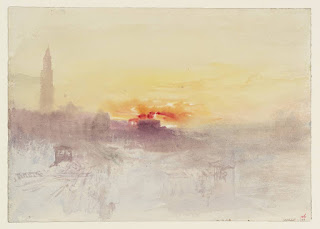Exhibition: "Ruskin, Turner and the Storm Cloud: Watercolours and Drawings"
Background
Following my visit to Brantwood, home of John Ruskin, I was pleased to see upon my return that York Art Gallery had an Exhibition on the works of Ruskin and JMW Turner. I felt that a visit to the gallery would provide me with a good opportunity to explore in more depth the works and ideas of both men.
The Exhibition
The exhibition was held to celebrate Ruskin's 200th birthday and to consider the relationship Ruskin had with the landscapes of JMW Turner. New research reveals the extent of Ruskin's response to Turner's vision, and how both artists expressed their own experiences of close looking at weather patterns, mountains and the built environment.
The exhibition also looked at a different angle. Ruskin suffered throughout his life from long periods of deep depression which worsened as he got older. As a result, our relationship with the environment and questions about mental health were explored through the watercolours and drawings of two of these most admired and celebrated artists of the 19th century. The Art Gallery created an activity leaflet to accompany the exhibition which I thought was innovative. The leaflet considers the nature of looking and how it relates to mental health. There are relevant quotes from Ruskin, information about both artists, and real life activities to do in the outdoors upon leaving the gallery.
I attach a copy of the leaflet below.
The exhibition also included art by Ruskin and Turner's contemporaries such as Constable, John Inchbold and Hubert Herkomer.
However, I was particularly interested in another angle to the exhibition. Contemporary artist Emma Stibbon RA had been commissioned to create a response to the environmental concerns raised by Ruskin. In the summer of 2018 she retraced his steps, travelling to Chamonix to draw and photograph the glaciers around Mont Blanc. She reflects on the effects of climate change on the Alpine landscape so treasured by Ruskin and Turner through a set of works exhibited in a separate gallery. This part of the exhibition was a good example of how we can learn from previous artists, build on their themes and make them relevant in today's society.
curators.
For these reasons the exhibition was very relevant to my area of practice, current ideas and research area. I also bought a book, To See Clearly: Why Ruskin Matters, by the curator of the exhibition, Suzanne Fagence Cooper, which I shall reflect on later, along with many of the other issues raised.
Works
The exhibition was curated to follow particular themes, which I summarise below;
- Ruskin and Turner (overview of their lives)
- Mountain Beauty
- Italy and Architecture
- Sounds
- War and Waste
- "The Sun is God" (Romanticism and Turner)
- Cloud Beauty
- Go to Nature (Nature Studies and Ruskin)
- The Lakes
- Ruskin's Bedroom (paintings by Turner)
- Nature and the power of Observation (Industrial Encroachment)
- "Heartily and Headily Mad" (Ruskin'd relationship with Rose la Touche)
- Climate Change and Erosion (Works by Emma Stibbon RA)
Examples
John Ruskin, View from my Window, Mornex, 1862, watercolour and bodycolour
John Ruskin, study of Rocks and Ferns, Crossmount Perthshire, 1847, pen, ink and watercolour
John Ruskin, Chamouni, Rocks and Vegetation, 1854, watercolour and bodycolour
JMW Turner, The Dormitory and Transept of Fountain's Abbey, Evening, 1798
JMW Turner, Constance, 1842, watercolour
JMW Turner, The Source of the Arveyron, 1802, watercolour
Works by Emma Stibbon
https://www.yorkartgallery.org.uk/exhibition/ruskin-turner-and-the-storm-cloud-watercolours-and-drawings/
https://www.youtube.com/watch?v=JLWeJAmBZIs
https://www.alancristea.com/artists/33-emma-stibbon/






















